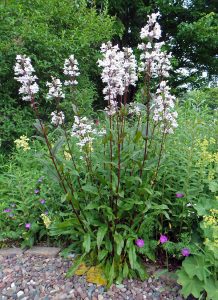
Penstemon is a large genus of herbaceous perennials in the plantain family (Plantaginaceae) native to North America. Most are best suited for western climates where there are leaner soils and less humid conditions. P. digitalis – commonly called foxglove beardtongue or smooth penstemon – is an exception, being one of the few penstemons that does well in areas with moist winters and humid summers. The species is found in prairies, fields, along the edges of woodlands or in open forests and along roads and railroad tracks in the eastern part of North America from eastern Canada to Virginia and from South Dakota to eastern Texas to Alabama. The cultivar ‘Husker Red’ was developed by Dale Lindgren at the University of Nebraska and released in 1983 with the name referencing the school’s color (and the maroon color of the foliage) and nickname, the Cornhuskers. It was the Perennial Plant Association Plant of the Year in 1996 and is hardy in zones 3 to 8.
This somewhat short-lived herbaceous rhizomatous perennial grows in a clump with a cluster of basal rosettes up to 2 feet wide. The cultivar ‘Husker Red’ has burgundy colored foliage while the leaves are green in the species and other cultivars. The species may be up to 5 feet tall but this cultivar is generally only 2-3 feet tall in bloom. The glossy basal leaves are somewhat variable but are generally elliptic with smooth margins and a rounded to pointed tip, and often having wavy edges. The opposite leaves further up along the flower stems are smaller, oblong to lance-shaped, and often toothed. The dark color of the foliage is most intense early in the growing season, becoming greener by summer.

Foxglove beardtongue blooms for about a month in mid-spring to early summer. One or more erect flower stalks emerge from the clustered rosettes, developing abundant flowers in panicles on the rigid deep purple stems. ‘Husker Red’ is more floriferous than the species. The tubular white flowers are up to 1¼ inches long, resembling the finger of a glove, emerging from the calyx with short, narrowly triangular lobes. The flower stalk, calyx and exterior of the flower are all covered in short, dense, sticky glandular hairs. Each flower has two lips, a white style and five stamens (the four with black tips appressed to the upper part of the tube are fertile and the one with a yellow tip is sterile; the common name of beardtongue comes from the tuft of small hairs on the sterile stamen). The upper lip has two rounded lobes and the lower lip has three rounded lobes that are slightly larger than the lobes on the upper lip. The scentless flowers, which may have a pink blush or fine violet nectar guides inside the corolla, are attractive to bees and butterflies, and may be visited by hummingbirds. They can also be used as cut flowers.

If not deadheaded, flowers are followed by rounded to egg-shaped seed capsules which can provide some ornamental interest as they persist into early winter. When ripe, the dry seed capsules split open to release the numerous small, finely pitted and irregularly angled dark seeds. Plants will self-seed but the foliage of the seedlings may not be as maroon as the parent plant.

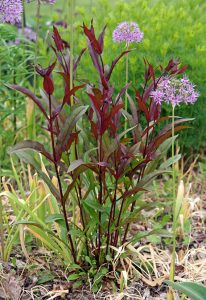
Although it can tolerate partial shade, grow ‘Husker Red’ in full sun for more intense leaf color. It does best in well-drained loam, but grows well in clay soils and is drought tolerant. When grown in rich soils, the flowers may require staking.
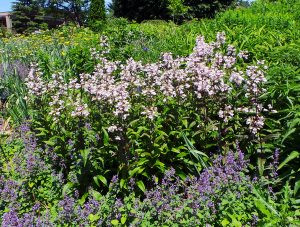
‘Husker Red’ beardtongue is a good addition to informal borders, cottage gardens, native plantings and wild gardens or naturalized areas. Combine a single plant with shorter companions with bright green foliage as a specimen, or plant many together for a mass of dark foliage and profuse white flowers. It works well in rain gardens as it tolerates periodic dry and moist conditions (but not always wet soil). It combines well with many native plants including blue flowered spiderworts (Tradescantia spp.), blue false indigo (Baptisia australis), and native grasses such as prairie dropseed. Try it with short catmints (Nepeta faassenii), lady’s mantle (Alchemilla mollis) and purple alliums.
‘Husker Red’ doesn’t have any serious pest problems, other than root rot if sited in poorly drained locations. It is not favored by deer and rarely browsed by rabbits. Propagate the cultivar by division in spring or cuttings taken in summer. Plants grown from seed may not have the dark-colored foliage that makes this cultivar so attractive. Seed ripens in the fall and germinates best with cold-moist stratification and light.
Some other cultivars and hybrids of P. digitalis include:
- ‘Dark Towers’ – a hybrid of P. digitalis ‘Husker Red’ and Penstemon ‘Prairie Splendor’ (created by Dale Lindgren), with large light pink flowers and glossy, darker red foliage that stays red longer into the summer.
- ‘Mystica’ – has bronze to maroon foliage in early spring, large light lavender pink flowers, and the leaves change to red in the fall.
- ‘Pink Dawn’ – has glossy, deep green foliage and flowers that are purple-pink on the outside and white inside. It is shorter than the species at only about 2 feet tall.
- ‘Pocahontas’ – has red foliage in spring and later deep green, burgundy washed leaves and lavender pink flowers.
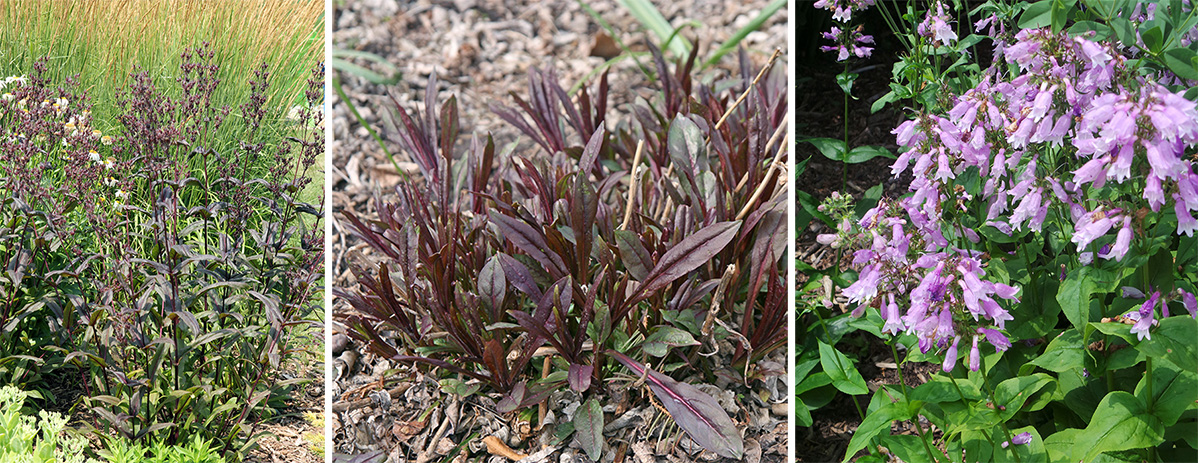
– Susan Mahr, University of Wisconsin – Madison





 Alternatives to Lawn: Groundcovers
Alternatives to Lawn: Groundcovers Marigolds
Marigolds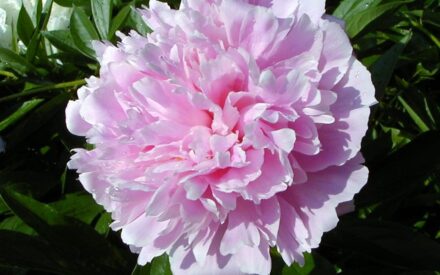 Peony
Peony Iris Severe Mosaic
Iris Severe Mosaic


